IAN attends CommOcean 2016 in Bruges, Belgium
Vanessa Vargas-Nguyen ·On December 6th to 7th 2016, Heath Kelsey and I represented the Integration and Application Network (IAN) at the 2nd International Marine Science Communication Conference (CommOcean) in Bruges, Belgium. The conference took place at the Provincial Court on the Market Square in the heart of the medieval Bruges, a historic UNESCO heritage site. It was my first trip to Europe, and my first conference to attend as both an IAN graduate student and session speaker.
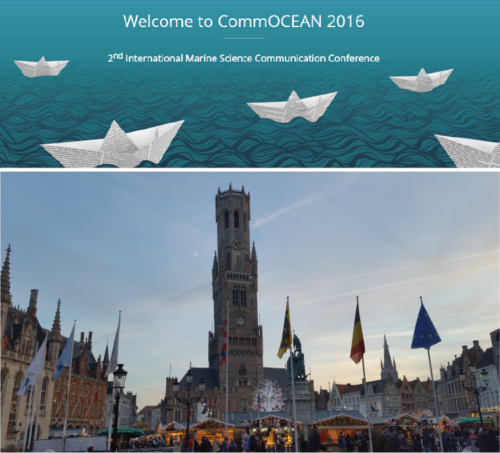
The event was organized by the Flanders Marine Institute (VLIZ), European Marine Board (EMB), European Marine Board Communications Panel (EMBCP), and the Intergovernmental Oceanographic Commission of UNESCO (IOC-UNESCO). Over 200 participants made up of scientists, researchers, and communicators from all over the world convened with the common goal of advancing the field of science communication for ocean/environmental literacy and bridging the gap between scientists and formal and informal education.
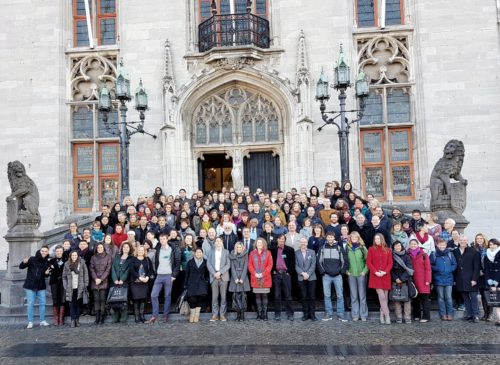
The conference had four major sessions – fundamentals of science communication and reaching out to the public, ways of optimizing impacts, use of social media and graphics, and future trends/new formats. Each session had two keynote addresses and 2-4 oral presentations in plenary, as well as 5 parallel sessions that were either themed sessions or interactive workshops. Both Heath and I presented on the 2nd day, under the “use of social media and graphics” session. Heath talked about the role of visual science in stakeholder engagement during the plenary session while my talk was on the use of ecosystem health report cards during the themed session on “tools & toolkits for outreach & governance”. Both our talks were well-received, and CommOCEAN proved to be the perfect venue and audience to showcase IAN's work.

For me, the conference can be best described in five I’s - interesting, informative, innovative, interactive and inspiring. During the very first keynote address, Paul Rose, renowned ocean explorer and broadcaster, demonstrated the power of good communication through his experience in creating powerful video documentaries and short clips. In addition, he imparted that for change to happen three things are important – good science, compelling media/effective communication, and political backing. There were also a lot of examples of different campaigns used to raise awareness, for instance, the story of how the name Boaty McBoatface became trending in Europe.
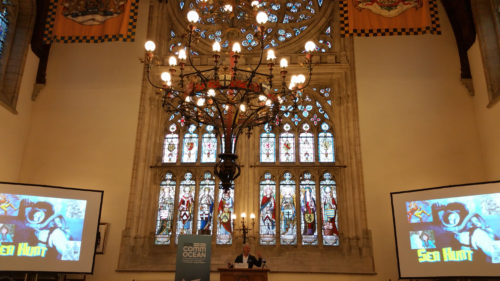
One effective communication strategy highlighted was engaging the youth, stressing the need for scientists to get out of their lab to interact with them directly. This was demonstrated in Ceri Lewis' keynote address on how an inconspicuous marine invertebrate became the hero of a climate change story, not a cute panda or polar bear, because of her educational outreach that included holding Skype Q&A sessions straight from the Arctic! Utilizing the power of social media and technology to reach out to the younger generation was also discussed in various sessions, one example was uploading short informative clips to Twitter. Various innovative new tools in ocean communication were also presented and featured. An example was the concept of the next generation science posters, introduced by SciComLab, where interactive “posters” come to life on big tablet-like screens!

CommOcean stood out from the other conferences that I have attended because of all the little things that spiced up the amazing plenary talks and parallel sessions. Aside from the grand venue, for starters, it sure didn’t hurt that the conference packet came with a cute notebook and a healthy bag of Belgian chocolates and other goodies! Innovations in communication strategies were certainly central and utilized during the conference. Christopher Malapitan of Visuality graphically recorded the entire event. It was very interesting to watch the story of the entire two days visually unfold live through graphics that were then connected by common themes.
Aside from the dedicated photographer, Els Verhaeghe, roaming the conference venue, a caricaturist can also be seen live in action. The poster competition also had an added twist - each presenter had to give a minute of live video presentation that was all uploaded on Facebook. Incidentally, the winner of the poster competition was presented with his own caricature!

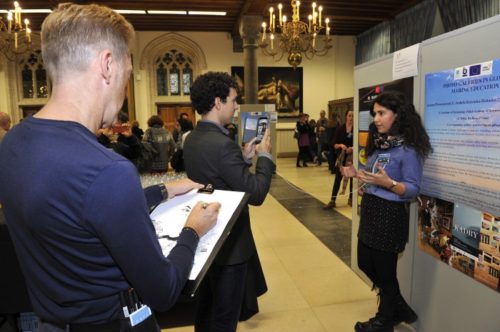
There were plenty of opportunities to network and interact with other participants during the session breaks, lunches and social events. On the first day, minstrels (medieval musicians) led the participants from the plenary hall to the lunch buffet downstairs, where they proceeded to play beautiful music while everyone ate and socialized. The welcoming reception on the evening of the first day was held at the prestigious Gothic hall of the Bruges Town Hall located at the Burg Square.
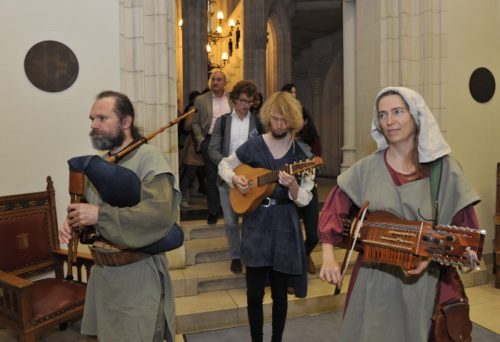
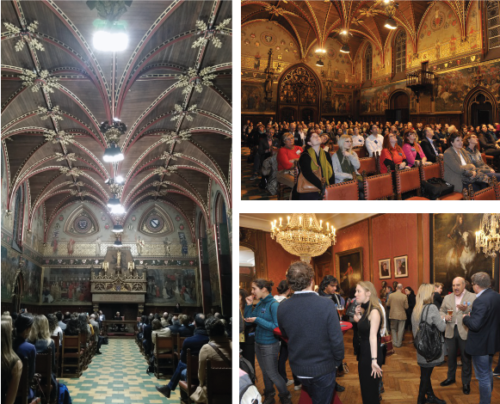
The social media team of CommOcean also did a great job with live Twitter feeds and Facebook updates; #CommOCEAN was trending and was followed from 41 countries all over the world! Another important underlying theme in the conference was that ocean and/or science communication is a skill set for the younger generation. It was quite apropos then that the wrap-up plenary included the awarding ceremony for the Professor Mario Ruivo Prize for the best original project by a team of 11-16 years old on the theme,"Your Ocean, Your Future".
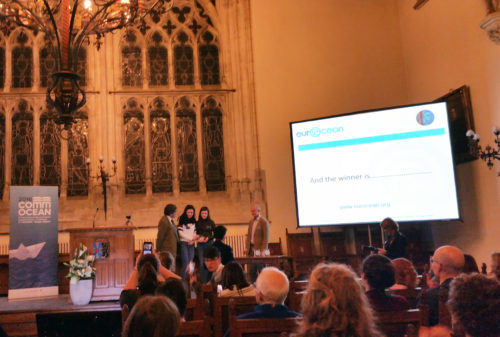
Aside from good communication and raising awareness, the conference also stressed the importance of inspiring action to bring about change. Central to this is the importance of engaging stakeholders, reaching out to the public, educating the youth, engaging the press, and having social media presence. These are things that both IAN and the University of Maryland Center of Environmental Science (UMCES) are currently doing as well.
The process of co-creation as an effective way to get stakeholder buy-in, as well as the power of storytelling and having a good narrative was a recurring theme throughout the conference. This reinforces that the work that we at IAN do can have a great impact in our society. It is also interesting to note that some of the things that we are considering to further develop our report card process were all mentioned and discussed during the conference in many different ways. These included stakeholder mapping and social network analysis, utilizing the different knowledge in the social sciences to promote behavior change and maximize impact, targeted communication and engagement strategies for different stakeholders (content contribution, citizen science, etc), and project monitoring and impact evaluation.
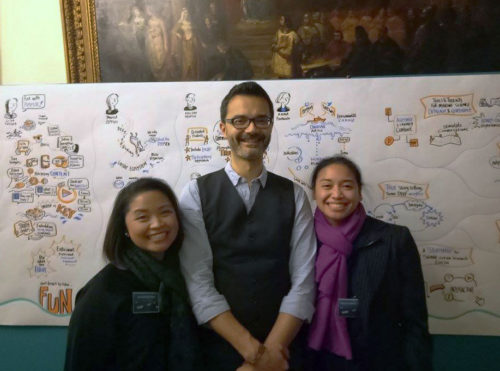
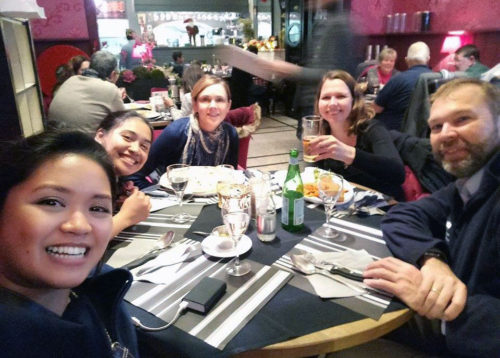
If I could have any complaint through this amazing experience, is that two days was too short for a jam-packed conference. It was very hard to choose which ones to attend from all the interesting parallel sessions. We also had to say goodbye to Bruges too soon and catch our train to Brussels as our flight the next day was early in the morning. I definitely learned a lot during these two days and met a lot of incredible people. IAN would be sure to watch out and send representations to future CommOcean events!
As eventful as this experience was, there was still one more stop before going home, Heath and I then met up with Bill Dennison to facilitate the Belmont Forum Synthesis Workshop in San Francisco!
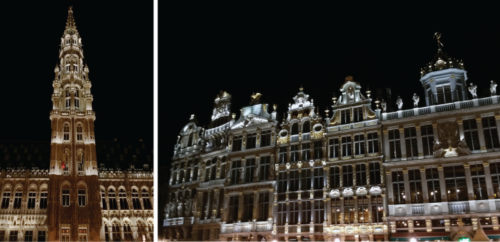
About the author
Vanessa Vargas-Nguyen
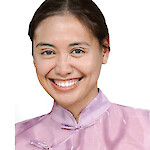
Dr. Vanessa Vargas-Nguyen is a Science Integrator with the Integration and Application Network and an associate faculty of the Marine Estuarine and Environmental Science Graduate Program. Her current interest is in transdisciplinary approaches, socio-environmental assessments, socio-environmental justice, stakeholder engagement, and adaptive environmental governance. Vanessa is originally from the Philippines and has extensive experience in molecular biology and marine science, specializing in microbial communities and molecular processes associated with Harmful Algal Blooms and shrimp, corals, and human diseases. She has since shifted her focus on how science can benefit society and was conferred with the first Ph.D. under the new Environment and Society foundation of the MEES graduate program. Her dissertation used ethnographic approaches to investigate the role of socio-environmental report cards in transdisciplinary collaboration and adaptive governance for a sustainable future. She received academic training from the University of the Philippines (BSc; MSc) and the University of Maryland (MSc; PhD). She is involved in developing holistic socio-environmental assessments for complex systems such as the Mississippi River and Chesapeake Bay watersheds and is coordinating a multi-year international transdisciplinary research consortium involving the US, Norway, Philippines, Japan, and India.